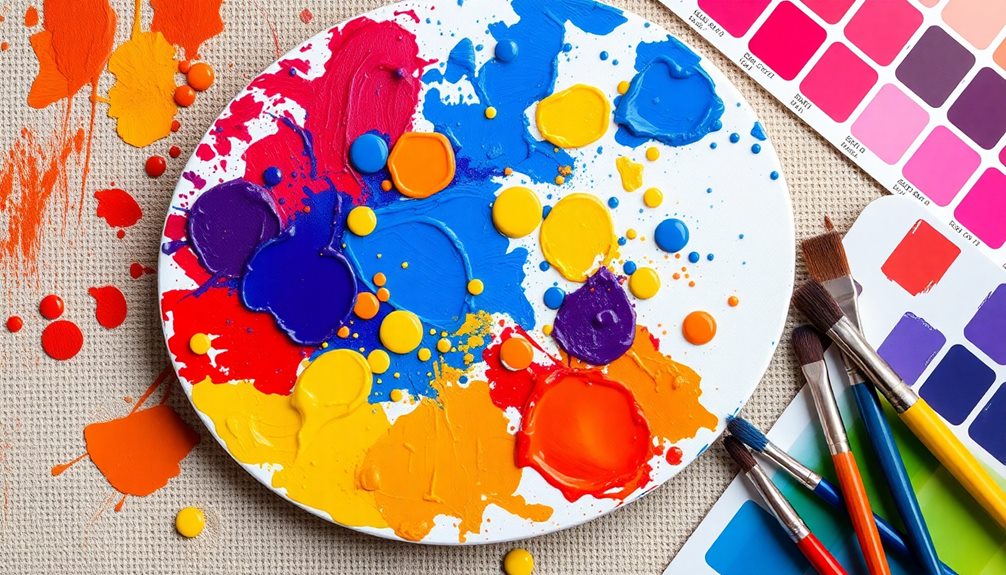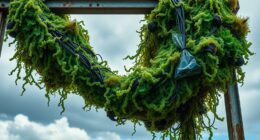When you approach academic art writing, focus on precise visual analysis rather than mere descriptions. Start with a strong thesis that highlights the artwork's significance. Structure your paper clearly, with distinct sections for introduction, description, and analysis. Always support your claims with visual evidence, and make sure to cite your sources correctly to avoid plagiarism. Engage with your audience's level of knowledge to enhance your arguments. Don't forget the importance of ethical sourcing for images. These guidelines form a solid foundation, and if you're curious, there's much more to explore about refining your writing skills.
Key Takeaways
- Focus on formal visual analysis to support your arguments rather than just describing artworks.
- Develop a strong thesis statement that highlights the visual significance of the artwork.
- Maintain a clear structure in your writing to enhance clarity and coherence.
- Use proper citation methods, following the Chicago Manual of Style, to avoid plagiarism.
- Engage in close visual analysis, considering elements like line, color, shape, and texture.
Introduction

In the world of academic art writing, a keen eye for detail is your most valuable tool. Developing strong writing skills in art history isn't just about putting words on a page; it's about engaging in thorough visual analysis that supports your arguments. Every research paper you write should move beyond simple descriptions of artworks, instead focusing on how visual elements contribute to your interpretive thesis.
To enhance your writing process, consider adopting an iterative approach that allows for continuous refinement of your ideas based on feedback.
Close visual analysis essays are common in introductory art history courses, so mastering this skill is essential. You'll need to adopt an inquiry-based approach, asking critical questions about form, space, and color. This method won't only deepen your understanding of the artwork but also enhance your critical thinking skills.
Make use of resources like "A Short Guide to Writing about Art" to refine your techniques and improve your effective communication. Don't hesitate to reach out to writing centers for additional support.
Key Concepts and Definitions

Understanding key concepts and definitions in academic art writing lays the groundwork for effective analysis and interpretation. In this realm, you'll often engage in formal analysis, emphasizing visual observations to develop your arguments. A strong thesis statement is crucial; it not only guides your writing but also articulates the significance of the visual elements you're examining.
Additionally, just as proper oral hygiene practices contribute to overall health, a clear structure in your writing enhances the clarity of your arguments, akin to establishing good oral hygiene habits early on.
When you write art history papers, proper citation and documentation are essential. Adhering to the Chicago Manual of Style helps you avoid plagiarism and enhances the credibility of your research. Be sure to include visual documentation, such as photographs or scanned images of the artwork, at the end of your paper. Each image should come with proper captions and references to ensure clarity and context for the reader.
Focusing on these key concepts will help you construct compelling analyses that resonate with your audience. By mastering these definitions and practices, you'll strengthen your academic writing and deepen your understanding of art history, making your insights more impactful and well-received.
Writing Process Breakdown

When tackling academic art writing, you'll find that the writing process hinges on a thorough visual analysis. Start by closely observing the artwork to develop a strong interpretive thesis. Using pre-writing strategies, like asking inquiry-based questions, can help generate ideas and guide your analysis.
Additionally, consider drawing parallels between artistic expression and other forms of sensory experience, such as how essential oils for relaxation can enhance the viewer's appreciation of art.
Next, create a well-structured outline that includes an introduction, visual description, analysis of form, discussion of opinions, and a final reflection on the artwork's broader context. This outline will serve as your roadmap, ensuring you stay focused on your argument.
Incorporate visual evidence throughout your writing to substantiate your claims. This evidence is critical in making your argument more compelling and credible.
Real-World Writing Applications

The skills developed through academic art writing have significant real-world applications that extend beyond the classroom. In an art history course, you learn to conduct visual analysis, which sharpens your observational skills and enhances your ability to interpret complex information. This skill translates directly to various fields, where critical thinking and detailed analysis are essential.
Writing requires synthesizing existing literature and articulating your arguments clearly, which is invaluable in any professional setting. Whether you're drafting a research proposal, creating content for a gallery, or writing a report, the ability to convey ideas effectively is crucial.
Moreover, engaging in original research during your studies prepares you for the demands of scholarly communication in the art world and beyond. Understanding proper citation styles, like the Chicago Manual of Style, ensures you maintain academic integrity while providing clear references for your sources.
Utilizing resources such as writing centers or guides like "A Short Guide to Writing about Art" can further refine your writing skills.
Ultimately, the competencies you gain through academic art writing empower you to succeed in various careers and contribute thoughtfully to discussions about art and culture.
Tips and Best Practices

To craft compelling academic art writing, it's crucial to engage deeply with the artwork through close visual analysis. Start by meticulously observing elements like line, color, shape, and texture. These observations should inform your thesis and argument development, ensuring your writing about art is grounded in solid analysis.
Maintain a clear structure in your academic writing. Organize your paper into distinct sections: an introduction, body paragraphs focusing on your visual analysis, and a conclusion that synthesizes your findings. Each claim or interpretation must be supported by visual evidence from the artwork.
Avoid grand claims or mere description; clarity and coherence are essential for a strong argument.
Utilize the Chicago Manual of Style for proper citations and documentation. This adherence is vital for maintaining academic integrity and providing a credible framework for your research.
Additionally, consult resources like "A Short Guide to Writing about Art" to refine your skills. Don't hesitate to seek feedback from professors or writing centers; they can help you address challenges and improve your writing.
Following these tips will enhance your ability to convey insightful analysis in your academic art writing.
Audience Engagement and Feedback

Engagement with your audience is essential for creating impactful academic art writing. By considering your audience's background knowledge and interests, you can enhance the relevance of your work. Tailoring your content to address their needs not only improves engagement but also increases the overall impact of your argumentation.
Incorporating feedback from peers or instructors is crucial. Their diverse perspectives can illuminate areas for improvement in clarity and strengthen your visual analysis. Don't hesitate to seek structured feedback from writing centers or academic workshops; these resources can guide you in refining your skills and articulating your analyses more effectively.
When you solicit specific feedback, focus on aspects like visual analysis and argumentation. This targeted approach leads to more robust interpretations of artworks and helps you construct a compelling narrative.
Additionally, regularly reviewing audience engagement metrics, such as reader responses or citation frequency, can inform your future writing strategies. These insights enable you to tailor your content to maximize its relevance and impact.
Ultimately, a strong focus on audience engagement and feedback can transform your academic writing into a more dynamic and persuasive exploration of art.
Ethical Sourcing of Images

Ensuring the ethical sourcing of images is vital for maintaining the integrity of your academic art writing. When you select images, always obtain them from reputable sources that provide proper attribution, such as museum archives or licensed databases. This practice helps you avoid copyright infringement and uphold academic integrity.
Many academic institutions and publishers require adherence to specific licensing agreements, like Creative Commons licenses, which dictate how you can use and share images. Verify the resolution and quality of the images you choose; high-resolution images are essential for clarity, especially when discussing intricate details in artworks.
It's also important to include detailed captions for each image. Provide context by mentioning the artwork's title, the artist's name, the date of creation, and its current location. This not only enhances your research's credibility but also aids your readers.
Lastly, ensure you cite images correctly according to citation guidelines like the Chicago Manual of Style (CMS). This practice not only maintains academic integrity but also creates a pathway for your readers to locate the original sources.
Additional Resources

Utilizing a variety of additional resources can significantly enhance your academic art writing. Start by consulting with your professors, as they can help address specific writing challenges and provide tailored feedback on your art writing assignments. This direct guidance can clarify expectations and improve your overall approach.
Consider making appointments at the Writing Center, where you'll find extra support and resources specifically designed to bolster your academic writing skills, particularly in art history. Their staff can assist you with everything from brainstorming ideas to fine-tuning your final drafts.
"A Short Guide to Writing about Art" is another invaluable resource, offering practical advice and strategies for effectively analyzing and writing about artworks.
Don't overlook the array of writing assistance tools available to you, including guides on citation styles, grammar tools, and templates to help structure your papers.
Frequently Asked Questions
What Are the 7 Essentials of Art?
The seven essentials of art are line, shape, color, texture, space, form, and value. You can use these elements to create compelling visual compositions that capture emotions and engage your audience effectively.
What Are the 7 Rules of Composition in Art?
The seven rules of composition in art are balance, contrast, emphasis, movement, pattern, rhythm, and unity. Each element helps you create visually appealing works that engage viewers and guide their experience through your art.
How to Structure a Formal Analysis for Art?
To structure a formal analysis for art, start by describing the artwork's visual characteristics and elements. Then, analyze its form, develop a thesis, support claims with evidence, and conclude with insightful connections to broader themes.
What Are the 8 Elements and 8 Principles of Art and Their Definition?
The eight elements of art—line, shape, form, space, color, value, texture, and pattern—create compositions. The principles—balance, contrast, emphasis, movement, pattern, rhythm, unity, and variety—organize these elements for harmony and visual interest.
Conclusion
In conclusion, mastering academic art writing empowers you to communicate effectively in the art world. By applying the guidelines and tips outlined, you can enhance your writing process and engage your audience more meaningfully. Remember to ethically source images and seek feedback to refine your work. With practice and dedication, you'll find your unique voice in this vibrant field, contributing valuable insights and perspectives to the ongoing dialogue in art. Keep writing and exploring!









